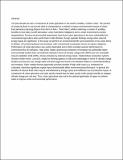| dc.contributor.author | Goldstein, Benjamin | |
| dc.contributor.author | Hauschild, Michael | |
| dc.contributor.author | Fernandez, John | |
| dc.contributor.author | Birkved, Morten | |
| dc.date.accessioned | 2020-12-18T15:39:35Z | |
| dc.date.available | 2020-12-18T15:39:35Z | |
| dc.date.issued | 2016-07 | |
| dc.date.submitted | 2016-05 | |
| dc.identifier.issn | 0959-6526 | |
| dc.identifier.uri | https://hdl.handle.net/1721.1/128854 | |
| dc.description.abstract | The past decade has seen a renaissance of urban agriculture in the world's wealthy, northern cities. The practice of producing food in and around cities is championed as a method to reduce environmental impacts of urban food demands (reducing distance from farm to fork – ‘food miles’) whilst conferring a number of ancillary benefits to host cities (runoff attenuation, urban heat island mitigation) and ex-urban environments (carbon sequestration). Previous environmental assessments have found urban agriculture to be more sustainable than conventional agriculture when performed in mild climates, though opposite findings emerge when external energy inputs are significant. In this study we perform an environmental life cycle assessment of six urban farms in Boston and New York City, US producing lettuce and tomatoes, with conventional counterparts across six impact categories. Performance of urban agriculture was system dependent and no farm provided superior performance to conventional for all indicators. High-yield, heated, greenhouse production of tomatoes has potentially higher environmental burdens than conventional methods in terms of climate change (267–369%) and non-renewable resource depletion (108–239%), driven primarily by external energy inputs. Heated lettuce production systems showed similar trends. Low-tech, empty-lot farming appears to hold some advantages in terms of climate change burdens and resource use, though water and land usage was found to be elevated relative to conventional lettuce and tomatoes. Open rooftop farming apparently provides benefits if high yield crops (e.g. tomatoes) are cultivated, otherwise significant capital inputs detrimentally affect environmental performance. In general, the benefits of reduced food miles may be overwhelmed by energy inputs and inefficient use of production inputs. A comparison of urban agriculture and solar panels showed that the latter would confer greater benefits to mitigate climate change per unit area. Thus, urban agriculture may not be the optimal application of space in northern cities to improve urban environmental performance. | en_US |
| dc.language.iso | en | |
| dc.publisher | Elsevier BV | en_US |
| dc.relation.isversionof | http://dx.doi.org/10.1016/J.JCLEPRO.2016.07.004 | en_US |
| dc.rights | Creative Commons Attribution-NonCommercial-NoDerivs License | en_US |
| dc.rights.uri | http://creativecommons.org/licenses/by-nc-nd/4.0/ | en_US |
| dc.source | Other repository | en_US |
| dc.title | Testing the environmental performance of urban agriculture as a food supply in northern climates | en_US |
| dc.type | Article | en_US |
| dc.identifier.citation | Goldstein, Benjamin et al. "Testing the environmental performance of urban agriculture as a food supply in northern climates." Journal of Cleaner Production 135 (July 2016): 984-994 © 2016 Elsevier Ltd | en_US |
| dc.contributor.department | Massachusetts Institute of Technology. Department of Architecture | en_US |
| dc.relation.journal | Journal of Cleaner Production | en_US |
| dc.eprint.version | Author's final manuscript | en_US |
| dc.type.uri | http://purl.org/eprint/type/JournalArticle | en_US |
| eprint.status | http://purl.org/eprint/status/PeerReviewed | en_US |
| dc.date.updated | 2019-08-05T15:03:24Z | |
| dspace.date.submission | 2019-08-05T15:03:25Z | |
| mit.journal.volume | 135 | en_US |
| mit.metadata.status | Complete | |
